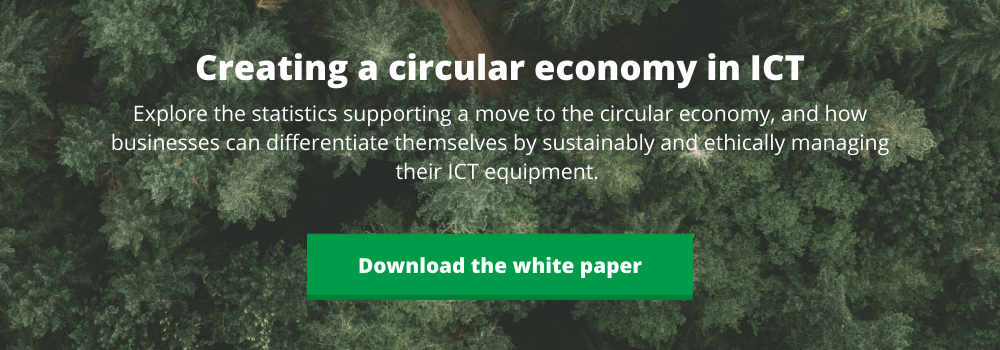As we approach the end of 2023 we are reflecting on a great year making progress on our goal to make a decade of difference to securely, safely, and sustainably transform and re-purpose 1 billion kgs of assets by 2030.
We are also looking ahead to 2024, considering global megatrends and upcoming changes that will affect IT lifecycle management. The IT landscape continues to experience rapid change, with advancements in technology, new laws and regulations, the rise of Artificial Intelligence (AI), and increased efforts to combat climate change amongst others.
This blog post considers what trends are predicted in the year to come and the impact we can expect on IT asset disposition (ITAD) and recycling. We explore what IT Asset Managers will need to know about ITAD in 2024 and how they can prepare.
Slow Economic Growth and Corporate Spending Plans
Predicting economic trends is always a challenging task, but based on current data, analysts are predicting that the global economy will continue to grow, albeit at a slower rate than in previous years. Slow growth or stagnation can result in lower corporate revenues and make organizations hesitant to invest in new projects or expand their operations. This might lead to companies tightening their belts when it comes to spending and taking action to weather the storm by focusing on innovation, cost-cutting measures, and strategic partnerships.
Despite this has been forecast that worldwide IT spending will grow with an increase of 8% in 2023. We can expect to see continued growth in cloud computing spending as more companies offload their owned infrastructure and move their operations to the cloud. We also expect an increase in investment in artificial intelligence (AI) and machine learning (ML) as businesses look for advancements and efficiencies through automation and data analysis.
Alongside this continued shift to online and automated operations another area where companies are expected to continue to spend, despite economic pressures, is cybersecurity. Strong cybersecurity measures are a must for companies to protect themselves against cyber-attacks and data breaches.
IT asset managers may see their asset portfolio evolve with requirements to manage cloud or collocated storage infrastructure alongside corporate IT inventory. A robust process to manage this equipment at end-of-life will be critical for businesses, as it can pose a significant security risk if not handled properly.
IT procurement professionals might want to consider opportunities to recover value from their IT inventory through their ITAD programs, by repurposing equipment for redeployment or reuse. You can discover what the residual value your IT and data center equipment might hold in our infographic.
Generative AI and Technology Development
The rise of generative AI and the development of new technologies has the potential to revolutionize ITAD and recycling programs as it will in many other industries. With the development of AI, there is a growing demand for IT equipment that can handle large amounts of data and manage complex algorithms. This demand is expected to increase as more companies adopt AI technology to improve their operations and gain a competitive edge.
With the increasing amount of data being generated by these technologies, it is essential for IT asset managers to have robust programs and policies in place to ensure all sensitive information is properly disposed of to prevent any security breaches. Proper repurposing and recycling of these IT assets will be crucial to managing IT budgets and recovering value from your asset inventory.
Furthermore, new tools and technology will lead to the development of new technologies and tools that can be used for IT asset disposition and technology recycling. These tools can help to automate processes, improve efficiencies in sortation and processing, identify units and parts suitable for reuse, improve material separation and automate inventory management and tracking. Those responsible for outsourcing ITAD programs will be looking for partners that are investing in new technology to move their processes forward.
Supply Chain Risk and Resilience Planning
Looking ahead to 2024 there is evidence that businesses across the board are placing an increasingly higher priority on resilience. One of the main drivers of this increased focus on resilience is the growing recognition of the risks posed by climate change. Extreme weather events, rising sea levels, and other environmental disruptions can have a major impact on businesses, from damaging physical infrastructure to disrupting supply chains and markets.
By investing in resilience planning, businesses can better anticipate and prepare for these types of events, which can help them minimize disruptions, maintain continuity, recover more quickly, and perhaps even gain a competitive advantage. Supplier resilience planning is an essential aspect of this and in 2024 we may see more attention on working with suppliers to prepare for potential disruptions to their supply chain.
One of the key steps for IT asset managers will be to identify key suppliers including their ITAD and recycling providers and assess the risks associated with their operations. This assessment should include factors such as the supplier’s financial stability, production capacity, and ability to handle unexpected events such as natural disasters or pandemics.
Sustainability and Action on Climate Change
A key reason for the increased focus on resilience planning is the growing recognition of the importance of sustainability and corporate social responsibility. In 2024, we can expect to see even more companies taking action to reduce their carbon footprint and mitigate the effects of climate change.
One of the main drivers of this is growing consumer awareness and demand for sustainable and responsible products and services. This means reducing greenhouse gas emissions, investing in renewable energy and implementing sustainable practices across their operations. For IT managers this could mean increased demand to source assets with a lower environmental footprint or equipment containing post-consumer recycling materials.
Redeploying or reselling IT equipment is an effective way to reduce the carbon footprint of technology use, and since it reduces spend, or recovers value, you don’t need to spend as much on new equipment. By repurposing equipment you reduce the amount of energy and resources required to produce new equipment and the demand for scarce raw materials.
Regulatory Changes in Sustainability Reporting
Another factor driving increased action on climate change is government regulation. Many countries are implementing policies to incentivise businesses to reduce their carbon footprints, such as carbon taxes, corporate sustainability reporting requirements, and emissions trading schemes. As these policies become more widespread, businesses will take more focused action on climate change.
While companies have traditionally focused on measuring and reporting on their own direct greenhouse gas (GHG) emissions, known as Scope 1, and emissions from their energy use, categorized as Scope 2 emissions. In 2024 an increased focus on measuring and reporting on upstream and downstream emissions, known as Scope 3, is expected. Scope 3 emissions are those generated indirectly by a company’s value chain, including suppliers, customers, and end-users.
Companies will look to their suppliers, including ITAD and recycling providers, to provide reporting on their own emissions profile, measure and report on their Scope 3 emissions, and take action to reduce their own emissions and improve their environmental performance. IT managers will be looking for suppliers that can meet their service needs, comply with sustainability reporting demands, and provide evidence of their own efforts and positive impacts.
In conclusion, as we look ahead to 2024, IT Asset Managers will need to be prepared to manage changing asset portfolios, develop robust ITAD programs and policies, and work with suppliers that can meet their service needs and comply with sustainability reporting demands. By staying informed and adapting to these trends, IT Asset Managers can help their organizations securely, safely, and sustainably transform and re-purpose assets in the years to come.







